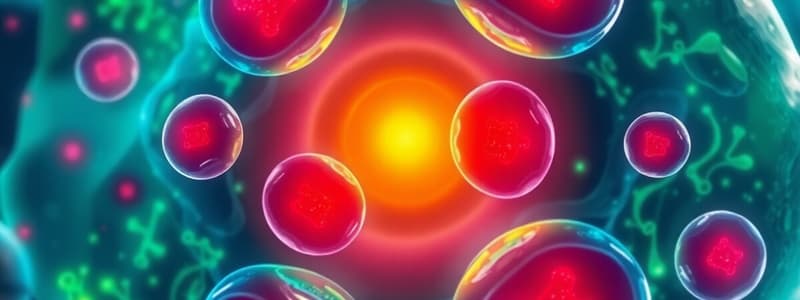Podcast
Questions and Answers
What is the primary role of mitochondria in cellular metabolism?
What is the primary role of mitochondria in cellular metabolism?
- Photosynthesis and nutrient storage
- Energy production through ATP generation (correct)
- Synthesis of ribosomal RNA
- Protein degradation and recycling
How do the cristae of mitochondria contribute to ATP production?
How do the cristae of mitochondria contribute to ATP production?
- By capturing light energy
- By facilitating fatty acid oxidation
- By increasing the surface area for oxidative phosphorylation (correct)
- By housing chlorophyll for photosynthesis
What evidence supports the endosymbiotic theory regarding mitochondria?
What evidence supports the endosymbiotic theory regarding mitochondria?
- Mitochondria produce ATP through glycolysis exclusively
- Mitochondria possess their own DNA and ribosomes (correct)
- Mitochondria have double membranes and perform photosynthesis
- Mitochondria are derived from peroxisomes
Which process primarily occurs along the cristae of mitochondria?
Which process primarily occurs along the cristae of mitochondria?
Which of the following structures is characteristic of chloroplasts?
Which of the following structures is characteristic of chloroplasts?
Which statement accurately describes the function of peroxisomes in eukaryotic cells?
Which statement accurately describes the function of peroxisomes in eukaryotic cells?
What is the primary role of mitochondria in eukaryotic cells?
What is the primary role of mitochondria in eukaryotic cells?
In terms of chloroplast structure, which component is essential for capturing light energy?
In terms of chloroplast structure, which component is essential for capturing light energy?
What best describes the process of oxidative phosphorylation?
What best describes the process of oxidative phosphorylation?
Which of the following concepts supports the origin of mitochondria and chloroplasts?
Which of the following concepts supports the origin of mitochondria and chloroplasts?
Which of the following statements correctly describes the function of peroxisomes?
Which of the following statements correctly describes the function of peroxisomes?
What structural feature of mitochondria enhances their function in energy production?
What structural feature of mitochondria enhances their function in energy production?
What process primarily occurs in mitochondria to produce energy?
What process primarily occurs in mitochondria to produce energy?
Which statement is true regarding the structure of peroxisomes?
Which statement is true regarding the structure of peroxisomes?
In the context of the endosymbiotic theory, which feature supports the idea that mitochondria originated from free-living prokaryotes?
In the context of the endosymbiotic theory, which feature supports the idea that mitochondria originated from free-living prokaryotes?
What is the primary role of catalase in peroxisomes?
What is the primary role of catalase in peroxisomes?
Which process is facilitated by the inner membrane of mitochondria?
Which process is facilitated by the inner membrane of mitochondria?
Which type of organelle is characterized as a site for detoxification and contains oxidase and catalase enzymes?
Which type of organelle is characterized as a site for detoxification and contains oxidase and catalase enzymes?
Flashcards are hidden until you start studying
Study Notes
Mitochondria
- Double-membraned organelles with an outer membrane and a highly-folded inner membrane called cristae
- The inner space is called the matrix, containing mitochondrial DNA and ribosomes
- Energy production: Generate ATP through oxidative phosphorylation that occurs along the cristae as part of the electron transport chain and chemiosmosis
- Cells with higher ATP requirements, contain more cristae
- Self-replicating and contain their own DNA and ribosomes, supporting the endosymbiotic theory of their origin
Chloroplasts
- Double-membraned organelles containing flattened sacs known as thylakoids, arranged in stacks called grana, surrounded by the fluid-filled stroma
Peroxisomes
- Small, membrane-bound organelles containing enzymes like oxidase and catalase
- Detoxification: Break down toxic substances and radicals, particularly hydrogen peroxide (H₂O₂), into water and oxygen via catalase
- Involved in fatty acid breakdown
Vacuoles
- Digestion: in some cells vacuoles contain hydrolytic enzymes for digestion
- Can also store water and other substances
Centrosomes and Centrioles
- Centrosome is a region near the nucleus containing a pair of centrioles
- Microtubule organization: The centrosome is the MTOC (Microtubule Organizing Center), which is crucial for spindle formation during cell division
- Centrioles are composed of microtubules arranged in a 9+0 pattern
Differences Between Eukaryotic and Prokaryotic Cells
- Eukaryotic cells: contain membrane-bound organelles like mitochondria, chloroplasts, Golgi apparatus, endoplasmic reticulum, and lysosomes
- Prokaryotic cells: lack membrane-bound organelles and are generally smaller than eukaryotic cells
- Eukaryotic cells have a nucleus that contains DNA, prokaryotic cells have a nucleoid region with their DNA where it is not bound by a membrane
- Eukaryotic cells have linear chromosomes and prokaryotic cells have a single, circular chromosome
- Prokaryotes reproduce asexually by binary fission, eukaryotic cells reproduce asexually by mitosis and sexually by meiosis
Studying That Suits You
Use AI to generate personalized quizzes and flashcards to suit your learning preferences.




